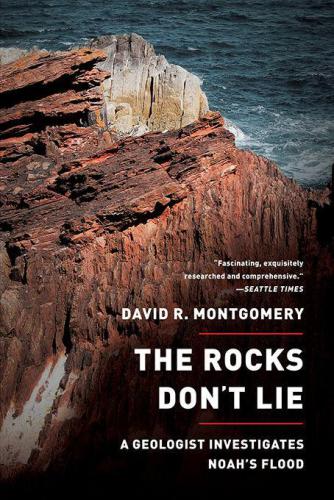
The Rocks Don't Lie
A Geologist Investigates Noah's Flood
کتاب های مرتبط
- اطلاعات
- نقد و بررسی
- دیدگاه کاربران
نقد و بررسی

Starred review from May 28, 2012
Many theologians and scientists within the Christian tradition have long interpreted the biblical story of Noah’s flood as a worldwide event and a foundation for determining the geological age of the earth. In this rich, animated narrative, geologist Montgomery points out that theologians have often bent an amazing array of geological evidence to support a literal interpretation of Noah’s flood. But what does the Earth itself tell us? Using the evidence he finds in the various strata of rocks in a roadbed in Kentucky, Montgomery contends that the “440 million-year-old, trilobite-bearing limestone” is clearly not a chaotic, mixed-up product of an earth-churning flood. The rocks formed when an ancient “proto-Atlantic Ocean” led to the formation of a thick pile of sediment that gradually accumulated layer by later—stretching from Newfoundland to Alabama. Moreover, plate tectonics shatters the myth of a global flood by explaining the sequences, ages, and assemblages of rocks we find throughout the world, as well as the global distribution of topography. Brilliant and provocative, Montgomery’s exploration of scientific and theological understandings of Noah’s flood vibrantly opens our eyes to the marvels of ancient rocks that are far grander than ourselves. 20 illus., maps. Agent: Elizabeth Wales, Wales Literary Agency.

June 15, 2012
Geology and history bring the relationship between science and religion into focus. For MacArthur Fellow Montgomery (Geomorphology/Univ. of Washington; Dirt: The Erosion of Civilizations, 2007, etc.), the science of geology provides a way to understand the relation between the Bible and the conception of nature coherent with modern science. "No other story," he writes, "has had as profound an influence on geology as that of Noah's Flood." Further, theologians have always manipulated geologic records to support literal interpretations of scripture. The author presents his view that "geologic time" provides a frame for "an entirely new creation story," which remains unfinished and ongoing, and he advocates the rebuilding of cooperation between science and faith. Examining a wide variety of flood and creation stories across centuries, Montgomery provides an enthusiastic and valuable recounting of the history of geology and how the advances in science have consistently faced opposition from the guardians of so-called religious authority, based on a literal reading of the Bible. The immense chronological spans and what is now known about the origins of the Earth and universe provoke the bitter opposition of the creationists. Montgomery insists that faith and science "can peacefully coexist," and his extensive documentation shows that the revival of creationism, as it exists today, has nothing to do with either science or faith. A forceful rallying cry for people of goodwill to join together to develop an alternative to the dangerous irrationalism that afflicts so many Americans.
COPYRIGHT(2012) Kirkus Reviews, ALL RIGHTS RESERVED.

Starred review from June 15, 2012
Many recent books have sought to reconcile (or tear apart) the relationship between religion and science, usually written by scientists or Christian leaders. Usually, the scientists depricate religious views as myths and fairy tales, while the religious writers bash opponents as godless manipulators of the evidence. Montgomery (geomorphology, Univ. of Washington; Dirt: The Erosion of Civilizations) offers a thorough critique of creationist worldviews (including Noah's flood) while treating his opponents with respect, reflecting on both ancient and modern debates and demonstrating that Christians have been arguing among themselves about these subjects for millennia. He admits that geologists have often stifled dissent and stubbornly rejected the idea that massive floods could have ever occurred, discounting such ideas as myths though there have, in fact, been many throughout human history. These catastrophic events likely inspired the famous stories of floods found around the globe, Montgomery concedes. VERDICT The combination of historical study and humility on behalf of geology makes for an extremely persuasive work. Highly recommended.--John M. Kistler, Washington, PA
Copyright 2012 Library Journal, LLC Used with permission.

Starred review from July 1, 2012
Geologist Montgomery's book is concerned with Noah's flood, but the investigation it recounts isn't merely his but also that of Western empirical science in a continuous dialectic between received truth and ascertained fact. Montgomery approaches it via field trips to Tibet and the rim of the Grand Canyon; in each place, you can practice geology, extrapolating how it was formed from how it looks. He then turns back to the ancient Greeks, calling Aristotle a protogeologist because he held that landscapes develop over the course of aeons and citing Philo's first-century commentary on Noah's flood for posing the key question of how extensive (worldwide or local?) the inundation was. Fathers of the church (e.g., Augustine) engaged that issue, and Reformation leaders, then Renaissance natural philosophers, followed. Geology proper began with Steno's law of superposition (1667), formulated from studying rocks and fossils directly. A hundred years on, George Cuvier and James Hutton were in the field, and scriptural inerrantists, biblical literalists, and, finally, creationists were indignantlybut not wholly unreasonably, Montgomery allowsreacting to what the rocks told the scientists. In a sense, Noah is the patron saint of geology, whose development has been spurred constantly by his legend. Though Montgomery obviously knows his science, he also knows how to write, so this isn't just history of science. It's literature.(Reprinted with permission of Booklist, copyright 2012, American Library Association.)

























دیدگاه کاربران